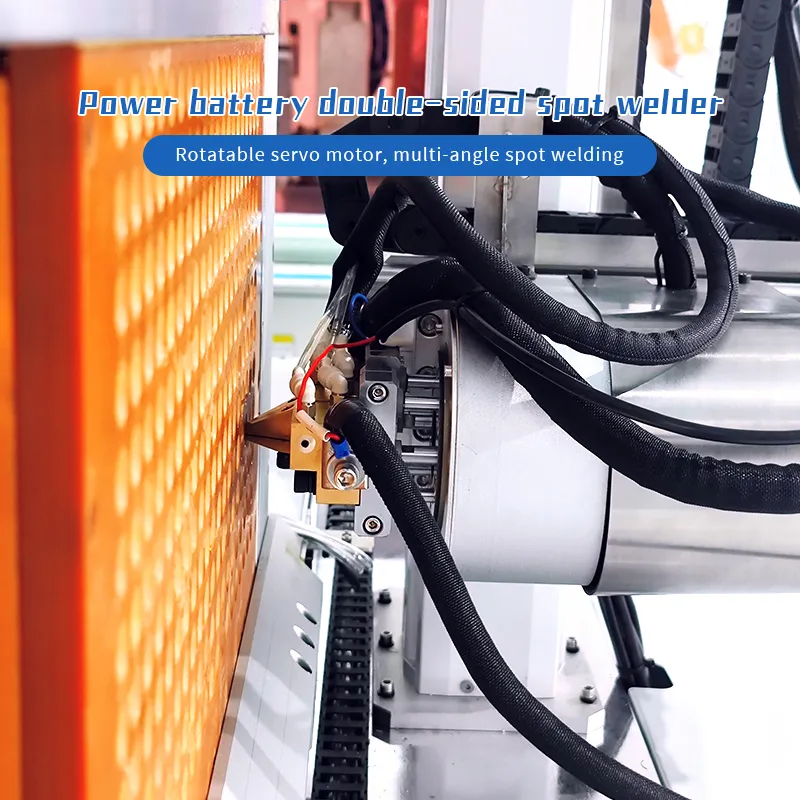
Features of the Automatic Spot Welding Machine
The automatic spot welding machine is designed for high precision and efficiency. Below are the key features:
High-Precision Sliding Track Mechanism
The country’s first high-precision sliding track sports mechanism ensures smooth and accurate operation during welding processes.Stable Welding Current Control
The pressure mechanism provides a stable welding current, ensuring consistent welds with high quality.Contactless Switch Adjustment
This feature allows for precise control adjustments without physical contact, improving the lifespan and reliability of the machine.High-Speed Single Chip Microcomputer Control
The machine is equipped with a high-speed microcomputer control system for precise and fast welding operation.Adjustable Closed-Loop Control
The system features constant current and constant voltage output, offering adjustable closed-loop control to optimize welding parameters.Automatic Overload and Voltage Protection
The machine has built-in protection mechanisms that automatically safeguard against overload and low voltage conditions.Storage of 18 Welding Parameters
The welding machine can store up to 18 sets of welding parameters, allowing for easy switching between different settings and materials.Output Current Monitoring
Real-time monitoring of output current ensures stable welding performance and helps prevent potential faults.Remote Computer Control
The machine supports remote control via computer, offering greater convenience for operators and ensuring optimal configuration and operation.
Capacitor Energy Storage in Automatic Spot Welding Machines
To further enhance the performance and reliability of the automatic spot welding machine, the capacitor energy storage system plays a crucial role. Below is an introduction to the key electromechanical energy storage components and their functions.
1. Key Components and Functions of Energy Storage
Triplet
The triplet is responsible for providing a clean and stable air source to the cylinder, as well as supplying lubricating oil to maintain smooth operation. It also ensures the proper air pressure for different welding processes.Control Box / Control Cabinet
The control box is the core part of the machine’s control system. It allows operators to set welding parameters based on different materials and thicknesses, ensuring perfect welding results.Solenoid Valve
The solenoid valve controls the actuator for gas flow, facilitating the up and down movement of the cylinder. It also adjusts the speed of the cylinder’s movement and minimizes operational noise.Cylinder Assembly
This assembly is responsible for the vertical movement of the upper electrode. It applies the necessary welding pressure to the workpiece, ensuring efficient and accurate welding.Push Button Switch
The push button switch acts as the main control for welding operations. It allows operators to turn the machine on or off, as well as initiate emergency stops if needed.
Operating Instructions for the Automatic Spot Welding Machine
1. Adjustment Procedures
Air Pressure Adjustment:
Set the air pressure of the cylinder to the required value before beginning welding operations.Welding Heat Setting:
Initially, set the welding heat to a lower value based on the material to be welded. Gradually increase it to the optimal level during welding.Testing:
Conduct a tensile or tear test on the welded workpiece to ensure the weld quality is up to standard.
2. Operational Steps
Powering On
Turn on the unit’s power supply.
Switch on the key power switch located on the control cabinet.
Initial Settings
Set the "empty range / welding" switch to the "empty range" position.
Set the "manual / automatic" switch to the "manual" position on the front panel of the machine.
Manual Adjustment
Press the “Start” button to initiate manual adjustments of the electrode position, cylinder pressure, and other parameters.
Welding Mode
Once adjustments are made, switch the "empty range / welding" switch to the "welding" position.
Press the "Start" button to begin welding with the adjusted settings.
Automatic Mode
After the manual adjustments are complete, set the "manual / automatic" switch to the "automatic" position.
In automatic mode, the machine will complete the welding process with a single press of the "Start" button.
Workpiece Placement and Welding Process
Manual and Automatic Operation:
If the workpiece is in manual mode, the operator must press the start button step by step to complete the sequence of operations. In automatic mode, the entire process is automated after placing the workpiece.
Place the Workpiece:
Place the workpiece on the lower electrode. Ensure that no other buttons are touched during placement to avoid accidents.Clamping and Welding:
In automatic mode, the machine will automatically clamp the workpiece using the lower fixture and cylinder pressure.
The upper electrode will then press down, and welding will take place. After the welding cycle, the machine will return to the starting position, and the lower fixture will release the workpiece.
Post-Welding:
After completing the welding process, the workpiece is released, and the system resets for the next cycle.
Safety and Operation Notes
Always ensure that the machine is operated by a trained individual, especially during manual mode.
Be cautious when placing workpieces, particularly cylindrical ones, to avoid accidental injury or equipment malfunction.
Conduct regular maintenance checks on components such as the solenoid valve and cylinders to ensure optimal performance.



